6
HKTS 220 SUB
Connecting the Subwoofer, Operating
Your Subwoofer and Specifications
Wireless Operation
When the wireless transmitter receives an audio signal from the source, it will immediately
turn on and the status LED will change to flashing green or solid green:
Green (flashing): Transmitter is on but has not established a link with the wireless
subwoofer
Green (solid): Transmitter is on and has already established a link with the wireless
subwoofer.
Red: Standby (no signal detected, transmitter off)
The transmitter will automatically enter the Standby mode after no audio signal is
detected from the source for approximately 10 minutes.
Wireless Code Settings
The Wireless Code selectors on the transmitter unit and subwoofer must be set to the
same position for the system to function correctly.
In the unlikely event that there is interference when operating the system, or if you have
more than one HKTS 220 SUB operating, you may change the channel at which the
system operates. Set the Wireless Code selectors on one subwoofer’s transmitter module
and subwoofer to one of the other three positions.
You can also set up a maximum of two subwoofers to receive audio from the a single
transmitter by setting the Wireless Code selectors on the transmitter and both of the
subwoofers to the same position.
Subwoofer Adjustments: Volume
Use the Subwoofer Level Control to set the subwoofer’s volume. Turn the knob clockwise
to increase the subwoofer’s volume; turn the knob counterclockwise to decrease the
subwoofer’s volume.
Notes on Setting Subwoofer Volume:
Sometimes the ideal subwoofer volume setting for music is too loud for films, while the
ideal setting for films is too quiet for music. When setting the subwoofer volume, listen to
both music and films with strong bass content and find a “middle ground” volume level
that works for both.
If your subwoofer always seems too loud or too quiet, you may want to place it in a
different location. See
Placing the Subwoofer, on page 3, for more information.
Subwoofer Adjustments: Phase
The Phase switch determines whether the subwoofer’s piston-like action moves in and
out in phase with the satellite speakers. If the subwoofer were to play out of phase with
the satellite speakers, the sound waves from the satellites could cancel out sound waves
from the subwoofer, reducing bass performance and sonic impact. This phenomenon
depends in part on the placement of all the speakers in the room.
Although in most cases the Phase switch should be left in the “Normal” position, there
is no absolutely correct setting for the Phase switch. When the subwoofer is properly in
phase with the satellite speakers, the audio will be clearer, have maximum impact and
make percussive sounds like drums, piano and plucked strings sound more lifelike. The
best way to set the Phase switch is to listen to music that you know well and set the
switch in the position that gives drums and other percussive sounds maximum impact.
Subwoofer Adjustments: Bass Boost
When set to the “On” position, the Bass Boost switch enhances low-frequency
performance, resulting in bass with more impact, which you may prefer while watching
movies or listening to music. There is no harm in experimenting with this control. Setting
the switch to the “Off” position will return normal low-frequency performance to your
system.
Specifications
Low-frequency transducer: 8" (200mm) down-firing cone
Amplifier power: 200 watts (continuous), 400 watts (peak)
Frequency response: 45Hz – 200Hz (–6dB)
Controls: Volume, phase, bass boost
Connections: LFE (RCA-type); left and right line-level
(RCA-type)
Enclosure type: Sealed
External trigger input voltage: 3 – 30 volts, AC or DC
Subwoofer power requirement: 120V, 60Hz (USA); 220V – 240V,
50/60Hz (EU)
Subwoofer power consumption: <0.5W (standby); 243W (maximum, 120V);
261W (maximum, 230V)
Subwoofer dimensions (H x W x D): 13-29/32" x 10-1/2" x 10-1/2"
(353mm x 267mm x 267mm)
Subwoofer weight: 19.8 lb (9kg)
Transmitter power requirement: 100 – 240V AC, 50/60Hz
Transmitter power consumption: <0.5W
Transmitter unit dimensions
(H x W x D):
1-3/8" x 5" x 3-1/2"
(35mm x 127mm x 89mm)
Transmitter unit weight: 0.26 lb (117g)

